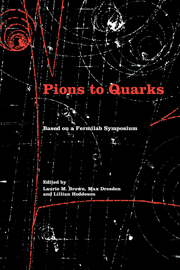Book contents
- Frontmatter
- Contents
- List of contributors
- Foreword by Leon M. Lederman
- Editors' acknowledgments
- Photographs of the symposium
- List of abbreviations
- List of notation
- I Introduction
- 1 Pions to quarks: particle physics in the 1950s
- 2 Particle physics in the early 1950s
- 3 An historian's interest in particle physics
- II Particle discoveries in cosmic rays
- III High-energy nuclear physics
- IV The new laboratory
- V The strange particles
- VI Weak interactions
- VII Weak interactions and parity nonconservation
- VIII The particle physics community
- IX Theories of hadrons
- X Personal overviews
- Name index
- Subject index
2 - Particle physics in the early 1950s
Published online by Cambridge University Press: 07 May 2010
- Frontmatter
- Contents
- List of contributors
- Foreword by Leon M. Lederman
- Editors' acknowledgments
- Photographs of the symposium
- List of abbreviations
- List of notation
- I Introduction
- 1 Pions to quarks: particle physics in the 1950s
- 2 Particle physics in the early 1950s
- 3 An historian's interest in particle physics
- II Particle discoveries in cosmic rays
- III High-energy nuclear physics
- IV The new laboratory
- V The strange particles
- VI Weak interactions
- VII Weak interactions and parity nonconservation
- VIII The particle physics community
- IX Theories of hadrons
- X Personal overviews
- Name index
- Subject index
Summary
What I shall discuss in this chapter is a collection of unconnected remarks about particle physics in the early 1950s.
One of the earliest international conferences on particle physics took place 17–22 September 1951 at the University of Chicago. I believe it was organized by Samuel Allison and his colleagues to celebrate the fiftieth birthday of Enrico Fermi. But Fermi did not want such a celebration, so the conference was named the International Conference on Nuclear Physics and the Physics of Fundamental Particles. It was supported by the Office of Naval Research (ONR) and the Atomic Energy Commission (AEC), and there were approximately 200 participants. In the proceedings of that conference, edited by Jay Orear, Arthur Rosenfeld, and Robert A. Schluter, one finds that the first session was begun with a talk by Fermi. Table 2.1 shows the list of elementary particles as presented by Fermi in that talk.
It is interesting that Fermi had no doubt about the existence of the antiproton, the antineutron, and the neutrino. The absence of the antineutrino in the table should not be taken as reflecting on Fermi's commitment to the Majorana neutrino. (I recall he regarded that as an unsettled question.) However, the V, τ, and K particles were in total confusion. Also notice that the names pion and muon had already been adopted in Fermi's talk.
- Type
- Chapter
- Information
- Pions to QuarksParticle Physics in the 1950s, pp. 40 - 46Publisher: Cambridge University PressPrint publication year: 1989



